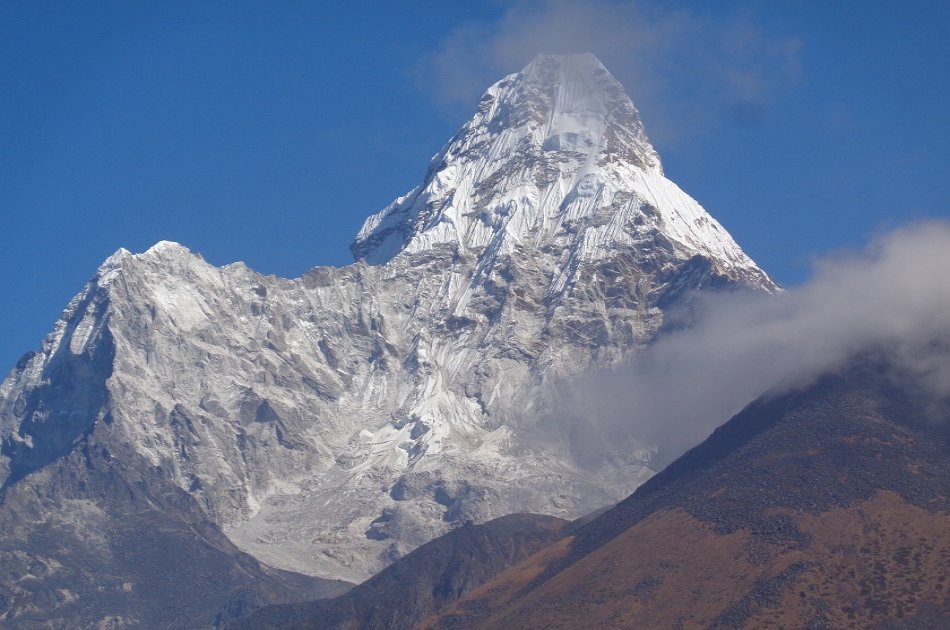Everest base camp trek 12 days
Everest Base Camp Trekking is also referred to as Everest Base Camp at the Kala Patthar region of Everest.
While the Everest Base Camp Trek offers a great opportunity to witness the world’s tallest mountain peak Mount Everest from a very close distance, the trek is also equally adventurous.
The major highlights of the Everest Base Camp Trek are Namche Bazaar, a popular region of Kala Patthar and the Everest Base Camp itself.
Everest Base Camp Trekking traverses through the majestic looking mountains clad with snow, colourful monasteries, the famous Namche Bazaar and the conserved region of the Sagarmatha National Park.
This also provides one with the opportunity of viewing at the Mountain Everest, the world’s tallest mountain peak, from an incredibly close distance.
- Namche Bazaar, a popular region of Kala Patthar
- See the worlds tallest mountain Mount Everest
 Scheduling: Shared Tour
Scheduling: Shared Tour
 Languages offered on the Activity / Tour: English
Languages offered on the Activity / Tour: English
 Duration: 12 days
Duration: 12 days
 Printed or Mobile Voucher Accepted
Printed or Mobile Voucher Accepted Pick-up servicePick up from Kathmandu airport.
Pick-up servicePick up from Kathmandu airport. Easy Cancellation100% Cancellation fee for customers to cancel 30 days prior to the tour and 50% cancellation fee 31-45 days prior to the tour.
Easy Cancellation100% Cancellation fee for customers to cancel 30 days prior to the tour and 50% cancellation fee 31-45 days prior to the tour.
 Confirmation will be received at time of booking
Confirmation will be received at time of booking
-
 Cut-off Time Available to be booked until 24 hours before the tour starts. We reserve the option to confirm the tour or not due to availability.
Cut-off Time Available to be booked until 24 hours before the tour starts. We reserve the option to confirm the tour or not due to availability.
- All land transfer, arrival, and departure as per the itinerary
- Hotel accommodation with bed and breakfast on Twin sharing basis as per the itinerary.Food during the trek 3 meals a day (breakfast, lunch, and dinner) in specified local lodges
- English speaking experienced & professional trekking guide license holder
- All necessary trekking related permit including TIMS, National Park Entrance fee, and ACAP Fee
- Insurance, proper warm clothing, shoes, sunglass and daily wages for guide and porter
- Necessary kitchen utensils
- Lunch and dinner while in Kathmandu or in Pokhara stay
- Personal gears and expenses of personal nature and Personal medical and travel insurance emergency evacuation
- Hard and any form of soft drinks
- All confectionary and snacks, Charges for desserts including shower and boiled drinking water, Phone calls, Laundry and Alcoholic beverages etc
- Tips and Gratitude for Guides and Porters according to a custom of trekking in Nepal
During the 40-minute flight from Kathmandu to Lukla (9,186ft), we enjoy one of the most beautiful air routes in the world culminating on a hillside surrounded by high mountainous peaks.
At Lukla, a gateway destination from where our trek begins, we meet our other crew members and begin packing and arranging with them.
From Lukla, we start trekking. At one hour’s gradual descent, we will be at a Cheplung village from where we have a glimpse of Mt. Khumbila (18900ft), a sacred mountain which has never been climbed.
From Cheplung, we then gradually descend until we reach Phakding and spend the night.
Walking through a beautiful pine forest, we follow the trail north up the valley of Benkar.
Then, we cross Dudh Koshi River and go on passing Chumoa to Monjo, the entrance to Everest National Park.
Then crossing a suspension bridge, we pass Jorsale village and walk alongside the Dudh Koshi and Bhote Koshi rivers.
A steep ascent brings us to the prime heartland of Sherpa village - Namche Bazaar.
At one hour’s distance to reaching Namche Bazaar, if the weather permits, we can view the sights of Mt. Everest and Mt. Lhotse. Overnight in Namche Bazaar.
There are plenty of things to do around Namche Bazaar, and we can spend a day here acclimatizing. Namche Bazaar is the main centre of the Khumbu region and has government offices, ATMs, Internet cafes, shops, restaurants, and a colourful market. Our guides can take us to explore the real charm of Namche Bazaar.
Hiking to Sagarmatha National Park rewards trekkers with a sunrise view and the views of Mount Everest, Lhotse, Nuptse, Ama Dablam, Thamserku, Kongde and so on. If we are interested in a day hike, we trek to Khumjung village (12401ft)-a beautiful village with a Sherpa settlement.
In exploring Namche Bazar, we observe traditional Sherpa life, Khumjung Hillary School and enjoy flora and fauna found at such altitude. Overnight in Namche Bazaar.
This segment of the trek includes the famous descent to the Dudh-Koshi River and the equally famous ascent along the rhododendron forests to Tengboche. While descending to Dudh Kish River, we enjoy the views of mountain tops like Mount Everest, Lhotse, Nuptse, Ama Dablam, Thamserku, Kongde and so on.
Upon reaching Tengboche, we visit Tengboche Monastery - the largest monastery in the region and soak in the views of Everest, Ama Dablam and other peaks. Overnight in Tengboche.
We descent and trek through forests filled with a variety of lush trees – birch, conifers and rhododendrons. This journey again rewards us with tremendous views of Mt. Everest, Lhotse, and Ama Dablam. The picturesque trail dips down to Devuche, crosses the Imja River and takes us to Pangboche.
The upper Pangboche trails reward us with a more pristine view of the Himalayas and the Pangboche Monastery. The trek moves ahead towards the Imja Valley, Lobuche River and ultimately begins climbing up to Dingboche. At Dingboche, we see a beautiful array of fields enclosed by stone walls to protect barley, buckwheat and potatoes from the cold winds and grazing animals. Overnight at Dingboche.
Dingboche is a popular stop for trekkers and climbers headed to Mt. Everest, Ama Dablam or Imja Tse. The village is beautiful with an array of fields enclosed by stone walls to protect barley, buckwheat and potatoes from the cold wind and grazing animals.
We spend a day at Dingboche for acclimatization. We take day hikes to either Nagarjun Hill or Chukkhung Valley for great views of Makalu, Lhotse, Chalotse, Tawache and Ama Dablam.
We start the day with a gradual climb to Duglha at the end of the terminal moraine of the Khumbu Glacier. From here, we climb up a steep trail to Chupki Lhara, where we find an array of stones with prayer flags used as memorials to Scott Fischer (American mountaineer) and 10-time Everest submitter Babu Chiri Sherpa (Nepali mountain guide) who perished on a mission to climb Everest.
Next, we continue to the Khumbu Glacier moraine and find ourselves facing several great peaks - Khumbutse, Lingtren, Pumori and Mahalangur Himal. The trail then eases off as we follow the valley to Lobuche. Overnight in Lobuche.
We take the trail to Everest Base Camp through the once vast Gorak Shep Lake. Continuing straight ahead, we come across the Indian army mountaineers' memorials. The path from here can be misleading; hence, it is important that we follow our lead Sherpa diligently. The walk is strenuous due to thin air in the high altitude. We pass through rocky dunes, moraine and streams before reaching the Everest Base Camp.
Upon reaching the Everest Base Camp, we see tents of mountaineers that stand out in bright colours against the monotony of grey surroundings (especially in the spring). Nuptse, Khumbuste and Pumori are the mountains we can view from the base camp. We get back to Gorak Shep for a good night's rest.
Overnight in Gorak Shep. However, the sunset view from Kala Patthar is more admirable than the sunrise view, so it is recommended that we visit Kala Patthar today during sunset. As the setting sun's rays strike the snow-capped mountains, the resulting scenery is incredible. Therefore, for those trekkers who wish to continue to Kala Patthar today instead of the next day please inform your guide and he/she will coordinate accordingly.
We prepare for an early morning departure, amid pre-dawn darkness and cold temperatures (-10 to -14 C). Plus, there is always the potential for chilly winds which are quite common. Familiar peaks such as Lingtren, Khumbutse, and Changtse tower to the east even as Everest begins to reveal itself.
But, it is upon reaching Kala Patthar that we get to see360 degree up-close and formidable views of Mt. Everest. We take pictures, enjoy the magnificent mountain panorama, and then return back to Pheriche for a good night's rest. Those participants who will visit Everest Base Camp today will have an early breakfast to start early as Everest base camp hike takes longer than the hike at Kala Patthar.
After returning to Gorak Shep, both the groups will have lunch together; afternoon time is taken to descend down to Pheriche for a good night's rest.
We trek down through the hillside blanketed by rhododendron and juniper trees. After crossing the prayer-flag festooned bridge over the Dudh Koshi River, our trail follows the Dudh Koshi gorge descending rapidly through pine forests. In the forest, we may come across colourful pheasants and mountain goats.
The path eventually reaches Sansa from where we can enjoy views of Ama Dablam, Thamserku and Nuptse mountains. We also pass winding trails then through a forest before reaching Namche Bazaar. Overnight in Namche Bazaar.
The trail descends steeply downward so we need to walk cautiously as our shaky legs continuously battle the rocky terrain. After crossing the suspension bridges over the fast flowing Dudh Koshi and its tributaries, the trail becomes more level and natural.
After our arrival in Lukla, we stretch those sore legs and recall the experiences of the last couple of weeks. Overnight in Lukla.
We catch an early morning flight to Kathmandu after our long mountain journey. After reaching Kathmandu, we can take a rest or do some souvenir shopping. If we want to explore any other areas of Kathmandu, we may do that today. Our guides can help you with both souvenir shopping or sightseeing.
There will be a farewell dinner in the evening to celebrate the successful completion of our journey. Overnight in Kathmandu.
- Best Time to Travel Spring (March to May) and Autumn (September to November) are the best months for this trip. Although this trip can be taken during winter, the cold temperature might not be suitable for everyone.
- Equipment & Packing List This list is a guideline to help you pack for your adventure. Also, understand that the items listed below will vary a little according to the season and the trek duration. Those items marked by an asterisk (*)are provided by Himalayan Glacier inclusive in the service. The weight limit for your luggage is 33 pounds or 15 kg. Remember that your luggage will be carried by your porter but you are required to carry a day-pack (with your valuables or anything important) on your own. We also suggest that you pack only what is necessary. Important documents and items Valid passport, 2 extra passport size photos, airline tickets Separate photocopies of passport, visa form (easily obtained at Kathmandu airport), proof of insurance Dollars, pounds or Euros in cash for purchasing Nepalese visa at Kathmandu airport, for paying for restaurants and hotels, for gratuities, snacks, and to purchase your own drinks and gifts Credit cards, Bank/ATM/Cash machine cards for withdrawing funds from cash machines (bring a photocopy of your cards), traveler's checks, etc.
- Head Bandana or headscarf, also useful for dusty conditions Warm hat that covers your ears (wool or synthetic) Headlamp with extra batteries and bulbs Sunglasses with UV protection Prescription sunglasses (if required) Upper Body Polypropylene shirts (1 half sleeve and 2 long sleeves) Light and expedition weight thermal tops Fleece wind-stopper jacket or pullover Waterproof (preferably breathable fabric) shell jacket Down vest and/or jacket * Gore-Tex jacket with hood, waterproof and breathable Hands 1 pair of lightweight poly-liner gloves.
- 1 pair of lightweight wool or fleece gloves 1 pair of mittens, consists of 1 Gore-Tex over mitt matched with a very warm polar-fleece mitt liner (seasonal) Lower Body Non-cotton underwear briefs 1 pair of Hiking shorts 1 pair of Hiking trousers 1 pair of lightweight thermal bottoms (seasonal) 1 pair of fleece or woolen trousers 1 pair of waterproof shell pants, breathable fabric Feet 2 pairs of thin, lightweight inner socks 2 pairs of heavy poly or wool socks 1 pair of Hiking boots with spare laces (sturdy soles, water resistant, ankle support, “broken in”) 1 pair of trainers or running shoes and/or sandals Cotton socks (optional) Gaiters (winter only), optional, “low” ankle high version Sleeping 1 sleeping bag (good to -10 degrees C or 14 degrees F)* Fleece sleeping bag liner (optional) Rucksack and Travel Bags 1 medium rucksack (50-70 liters/3000-4500 cubic inches, can be used for an aeroplane carryon) 1 large duffel bag * A small daypack/backpack for carrying your valuables, should have good shoulder padding Small padlocks for duffel-kit bags 2 large waterproof rucksack covers (optional) Medical Small, personal first-aid kit. (simple and light) Aspirin, first-aid tape, and plasters (Band-Aids) 1 skin-blister repair kit Anti-diarrhea pills Anti-headache pills Cough and/or cold medicine Anti-altitude sickness pills: Diamox or Acetylzolamide Stomach antibiotic: Ciprofloxacin, etc. Do not bring sleeping pills as they are a respiratory depressant.
- Water purification tablets or water filter 1 set of earplugs Extra pair of prescription glasses, contact lens supplies Practical Items 1 small roll of repair tape, 1 sewing-repair kit 1 cigarette lighter, 1 small box of matches 1 compass or GPS(optional) 1 alarm clock/watch 1 digital camera with extra cards and batteries large Ziplocs 2 water bottles (1 liter each) 1 small folding knife Binoculars (optional) 4 large, waterproof, disposable rubbish sacks Toiletries 1 medium-sized quick drying towel Toothbrush/paste (preferably biodegradable) Multi-purpose soap (preferably biodegradable) Deodorants Nail clippers Face and body moisturizer Female hygiene products Small mirror Personal Hygiene Wet wipes (baby wipes) Tissue /toilet roll Anti-bacterial hand wash Extras/Luxuries Reading book Trail map/guide book Journal and pen iPod Travel game i.e. chess, backgammon, scrabble, playing cards (to help you pass the time at teahouses and/or camps) 1 modest swim suit Binoculars (optional) Voltage converter (from 220 to 110) Plug adapter (2 round pegs to 2 flat pegs) Lightweight pillow case (in case your teahouses provide you with pillows) or use your own stuff as a pillow.




 Product code: 4617
Product code: 4617  © Copyright 2024 Private Tour Inc. All Rights Reserved.
© Copyright 2024 Private Tour Inc. All Rights Reserved.